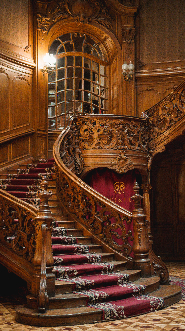Rediscover the baroque style and its extravagant decoration, an artistic and architectural movement that reigned in Europe for much of the eighteenth century. From religious architecture to decorative arts, Baroque taste has influenced European creativity for centuries and continues to inspire designers from all walks of life. Immerse yourself in this fascinating universe and discover how it can blend harmoniously with modern interior design.
The history of the Baroque movement in Europe
The Baroque style is an artistic movement that began in Italy in the sixteenth century and quickly spread throughout Europe. It developed during the classical period, between the 1600s and 1750s.
The Baroque style was influenced by earlier artistic currents such as the Italian Renaissance and Spanish Mannerism.
Origin and diffusion of the Baroque style
The Baroque style appeared in Italian regions such as Rome, Venice and Florence. However, it was only once the movement took root in the rest of Europe that it was able to grow.
This happened mainly through the diplomatic activity of some European monarchs, who spread the movement across the continent.
The Baroque style gained popularity through its use to create places of worship for various religious denominations, especially among Catholics. Churches and buildings were built to celebrate the faith and represent their religion.
Characteristics of the Baroque style
The main features of the Baroque style include extravagant decoration, dynamic and fluid forms, noble materials and highly decorated interiors. Works from the Baroque era are characterized by complex compositions that emphasize movement, bright colors, and an abundance of architectural detail.
In addition, the Baroque style advocates the use of many carved or hand-shaped ornaments to give the pieces a rich and luxurious look. Another distinctive feature of the Baroque style is its distancing from the idea of aesthetic perfection pervasive in the classical arts.
The differences between the Baroque and other styles of the classical period
Although the Baroque style shares some of the same stylistic characteristics with other contemporary styles such as the Italian Renaissance or Spanish Mannerism, it is distinguished by its more fluid view of design and its freer consideration of complex ornamentation. The Baroque style also marks a radical change from the strict rules imposed by academicism and the need for artists to achieve some sort of aesthetic perfection.
As a result, the Baroque style was very influential in European art and architecture of that time.
The influence of the Baroque style in architecture

The use of the Baroque style in Catholic churches
One of the main uses of the Baroque style was in religious architecture, mainly in Catholic churches. The main purpose of this type of construction was to produce spaces that express religious sentiment and simultaneously serve as a means of displaying the grandeur and richness of monarchs. The antique chairs were made of solid wood adorned with rich sculptures.
The interiors of buildings are usually adorned with intricate carvings, colorful murals, fountains or other ornaments present to create an often spectacular effect.
Features of Baroque architecture
The main architectural features of the Baroque style include: symmetrical general plans, a wide columned porch carrying a large overhanging tower and often intricate balustrades with flat windows and roofs. The materials used to build are usually stone and marble.
Wrought iron openings are also frequently used to illuminate rooms through stained glass windows or any other decorative material.
Examples of Baroque works of art in Europe
Many works of art representative of this era are still visible across Europe. Among the most famous are the Basilica of Santa Maria dela Victoire in Rome (1626), St. Peter's Cathedral in Rome (1646) and the Royal Palace of Madrid (1629).
These works were all created by talented architects to reflect the European Catholic monarchs' taste for luxury and rich ornamentation.
Baroque style in interior design
The use of the baroque style in interiors
The Baroque style has also influenced contemporary interior designers and decorators. The trend of the modern Baroque style is characterized by carved furniture, rectangular Baroque mirrors, bright colors and an abundance of moldings and other intricate ornaments.
Classic interiors often have highly structured furniture that is suitable for darker rooms, while the baroque style is more in line with light colors. The furniture is designed to be luxurious, filled with intricate carvings and patterns.
Soft rugs are also frequently used to add to the overall ambiance.
Features of baroque decoration
The main features of Baroque decoration include the use of a wide range of warm colors, such as red, yellow and gold; objects accented with gold or silver; a variety of rich materials such as velvet, silk and leather; and tiles covered with splendid ceramic mosaics. The baroque style is also paired with a strong color palette that can be integrated through colorful fabrics, bold wallpapers, or even an ornate ceiling in a dining room or living room.
Examples of baroque interior design popular today
There are several ways in which one can integrate the baroque style into a house. Here are some popular examples:
- Velvet-covered sofas with dynamic shapes
- An oval coffee table decorated with carved wooden ornaments
- A large, sophisticated chandelier to illuminate a dark seating area
- A carpet with intricate patterns to dress a cold floor
- A richly decorated wall with sculptures or figures in relief
Together, these elements can create a luxurious interior that harks directly back to eighteenth-century Europe.

